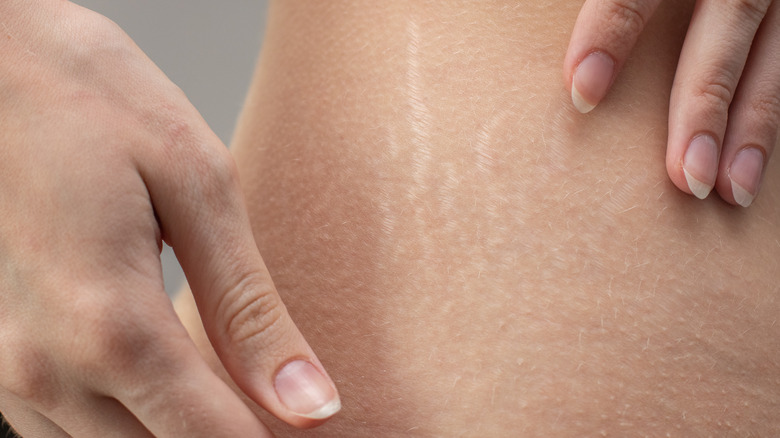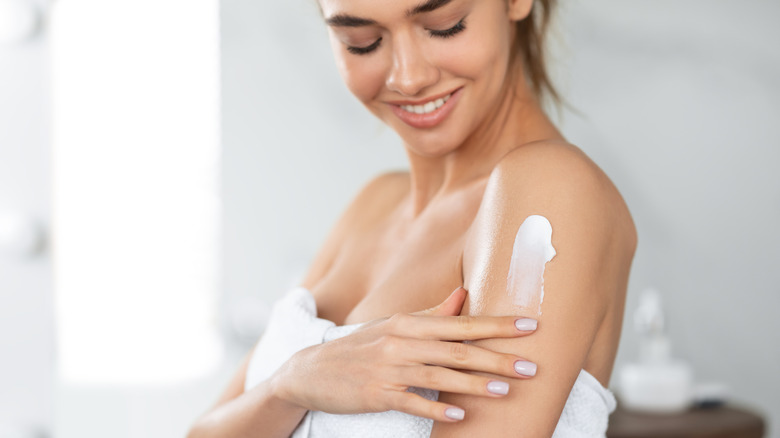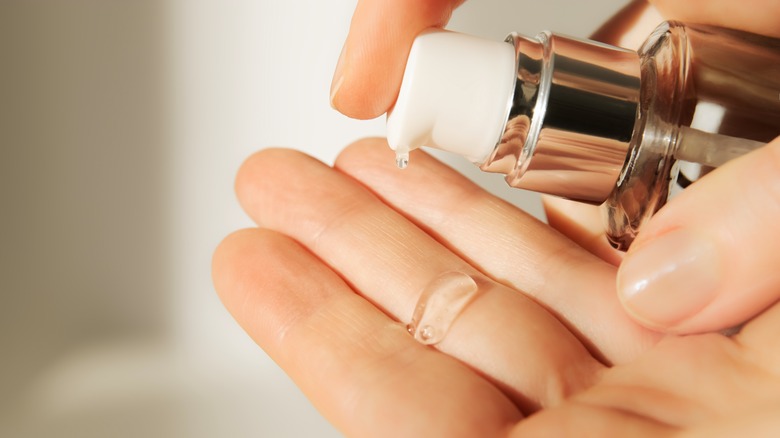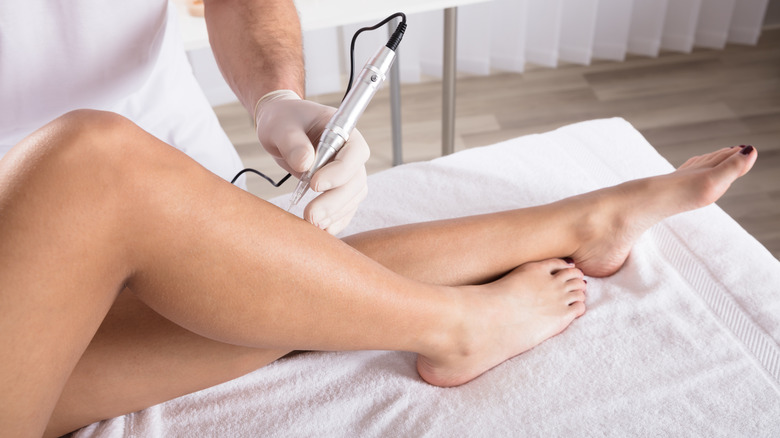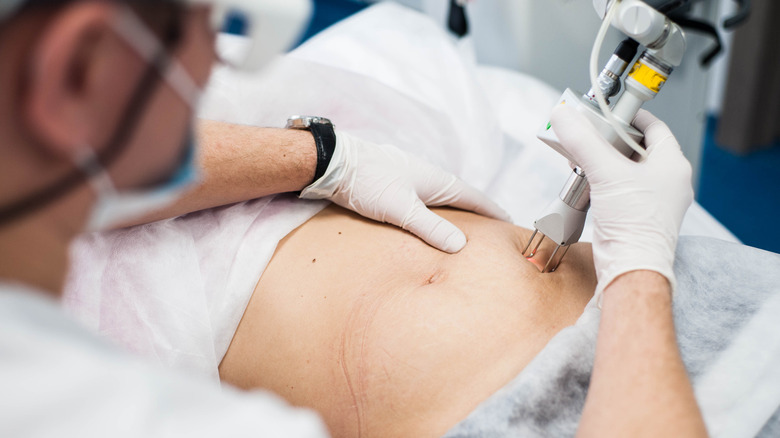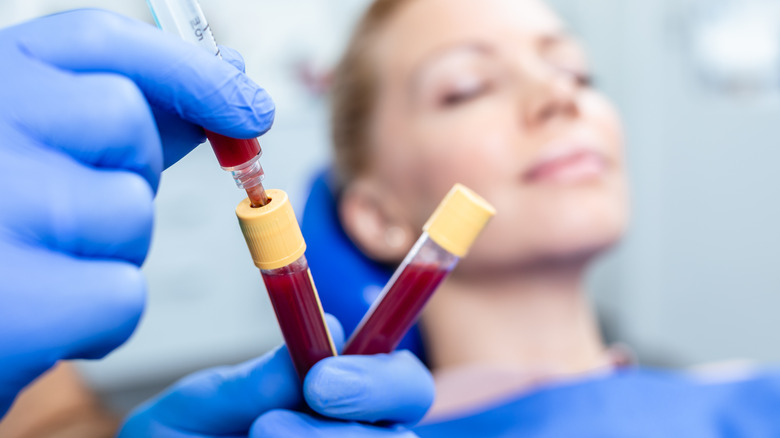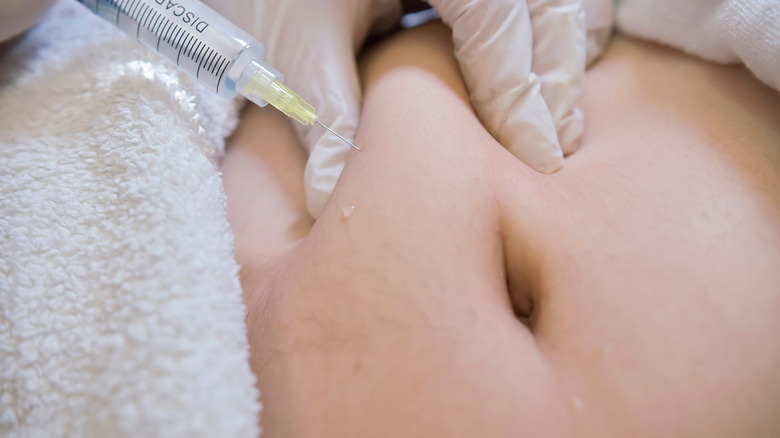10 Tips For Reducing The Appearance Of Stretch Marks
We may receive a commission on purchases made from links.
It's finally becoming more commonplace for stretch marks to be celebrated as part of our characters — even supermodels are embracing them, per NBC — rather than scorned as flaws, but that doesn't mean that you have to be buddies with yours if you don't love them. According to the Mayo Clinic, stretch marks can vary in color and size depending on how long you've had them, what caused them, and where they are on your body.
Stretch marks appear when the skin is stretched due to some kind of skin trauma, and it does not have the necessary elasticity to keep from ripping. Essentially, stretch marks are portions of the skin where the skin barrier is thinner. Usually, fresh stretch marks will be dark, red, or purple in color, and they might even feel sore. Older stretch marks will fade to white-pink and will sometimes be tender if poked.
Certain people might be more prone to getting stretch marks throughout their lifetime. Risk factors that increase your chances include having a personal family history of stretch marks, being pregnant, rapid growth (whether as an adolescent or through weight gain), using anabolic steroids or corticosteroids, or having a genetic disorder such as Cushing's or Marfan syndrome. Stretch marks don't really affect your quality of life for most people but you still might not be on board with keeping them around. Many women and men are ready to part ways with theirs, so if you're in that boat, we've got the tips for you.
Prevent with moisturizers
If you haven't yet developed stretch marks, don't think you're out of the woods. The risk factors above can be applied to many years of a lifetime so if you think you're going to come up on some soon, prevention is always the best offense, according to Stretchmarks.org. That way, you're already ahead of the curve on stretch marks.
If possible, everyone likes to save a buck or two, especially when it comes to issues that are long-term. So, let's start with what you can do at home. One of the best things you can do is invest in some good moisturizing products that will keep your skin supple and soft throughout any stage of life. The softer and more hydrated/moisturized your skin is, the less likely it will tear if, or when, it is stretched.
There are, of course, hundreds, if not thousands, of moisturizing products on the market. There's no need to make it complicated, though. Simple cocoa butter or even coconut oil will work well to keep your body's skin hydrated, soft, and supple. As long as you are religiously applying moisturizer to all parts of your skin, your skin should be able to take any kind of stretching. Make sure to be especially mindful of your abdomen, thighs, upper arms, buttocks, and breasts, as those areas are most likely to develop stretch marks.
Nourish with oils
Our skin can also benefit from the nutrition, on top of their moisturizing properties, that is available in many applicable oils, on top of the fact that many of the following oils are also highly moisturizing. As before, there's no need to be especially complicated with your selection. Coconut oil can perform double duty as a moisturizer and also deliver some vitamin E, but other oils are more effective than coconut oil.
In a 2010 study published in Pharmacognosy Magazine, grapeseed oil was found to be especially beneficial for the elasticity and suppleness of the skin, and it also helps the vitamin E and C in your skin to be used more efficiently. The same study also determined that an oil infusion, which included grapeseed and olive oils, of the herb kapoor kachari, or spiked ginger lily, was one of the most beneficial ingredients to improve hydration and viscoelasticity of the skin.
Oils can also be used as serums or with other products that can boost their effectiveness at entering the skin and providing benefits for longer. Glycolic acid, for example, is a humectant, which means that it draws and binds water to skin cells (via Dictionary.com). Therefore, it is very beneficial to improving the amount of water in your skin, helping to meet your skin's hydration needs.
Feed with food
Making sure that your body is protected from the outside is one thing, but the inside is where it can really make a difference. Even in-office treatments of stretch marks rely on the body's ability to restructure and heal in many instances, but more on those later. If you want to keep the stretch marks at bay, increase your intake of collagen, protein, and vitamins C, D, and E.
Collagen is one of the most abundant proteins in your body, and it decreases in production as our bodies age. There are multiple types of collagen, but type 3 is the kind found in the skin. This type helps to strengthen, hydrate, and improve the elasticity of your skin. A review of 11 different studies in the Journal of Drugs in Dermatology found that taking even as little as 3 grams of collagen per day orally helped to improve skin health. You can also increase your protein intake to reach your daily amount of collagen.
Vitamin C is also a necessary nutrient needed for the synthesizing of collagen, so eat foods such as broccoli, citrus, and bell peppers to get your daily intake. What's more, according to a case-referent study in the Journal of Dermatology Research and Practice, deficiencies in vitamin D have also been loosely linked to an increase in stretch marks. However, zinc plays a role in the wound healing process — stretch marks are essentially skin wounds — and in reducing inflammation, so ensuring that your vitamin and mineral needs are met is paramount.
Hit the pharmacy
If you've already noticed stretch marks on your body and aren't willing to put up with them but also don't have the hundreds to spend on doctor visits, consider some non-prescription and even drugstore options first. There are a few great products on the market that can help.
For instance, products such as Bio-Oil's Multi-Use Skincare Oil and Pai's Stretch Mark System can be great alternatives to minimize and fade your stretch marks. Bio-Oil has been lauded for its skin benefits since its inception, and many a mom has been grateful for its help in keeping stretch marks at bay during pregnancy. It can also be used to help minimize the appearance of already present stretch marks as well.
Pai's System is also touted for its stretch mark fading prowess and has many glowing reviews of the kind. Of course, don't expect these kinds of products to work overnight — or even by the end of the week. While minor differences might be visible to you within a short amount of time, typically two weeks to a month, patience and constant application are needed to see a major difference in your stretch marks. Non-prescription products will likely not completely rid your body of stretch marks, either. Depending on the size and color of your marks, pharmacy products will usually fade them or minimize their size, but they can't completely make them disappear.
Invest in retinol
If you're ready for some bigger guns, try retinol for improving stretch marks. Retinol is the acidic variation of vitamin A and is commonly used for treating acne but can be beneficial when treating stretch marks, too. Retinol works by increasing cell turnover, which means that the top layer of your skin exfoliates faster with regular retinol applications. Consequently, new skin layers are made. Since stretch marks are basically where the skin is thinner or where it has scarred over, retinol's ability to increase the speed at which your body creates new skin cells can fade the appearance of stretch marks. Retinol works better on newer stretch marks but can be effective against old ones, especially if they're smaller.
Retinol can be found as over-the-counter lotions or serums, but stronger (higher percentage of retinol per additives) mixes can be prescribed by dermatologists, per Skincare.com. Of course, over-the-counter retinol will take longer to produce results, while prescription strength ones can have visible success in a few weeks. Stronger is not always better, though, especially if you have sensitive skin, as retinol in prescription-strength form can be highly irritating.
The most important thing to note with retinol, because it can be irritating to the skin by itself and also increases cell turnover rates, is that wearing sunscreen is a must. Wherever you're applying retinol should always be covered up with clothing or sunscreen to minimize the effects of ultraviolet light on already sensitive skin.
Go strong with tretinoin
Tretinoin is the prescription-strength version of retinol, and it's usually applied in the form of a cream or gel (via Healthline). It is usually sold under brand names such as Retin-A, Tretin-X, and Rejuva and also in some combination creams, including Solage and Ziana. It is mostly used to treat acne and wrinkles, but it works on myriad other skin conditions as well.
There are only a few differences between retinol and tretinoin, the major one being that retinol is a natural source of vitamin A, while tretinoin is a synthetic version of vitamin A. Tretinoin is much stronger than retinol, so if retinol hasn't worked for you, you can try tretinoin for your skin. Since tretinoin is a stronger version of retinol, it should be used with caution especially at first. Your skin can be sensitive to the higher percentage and potency of vitamin A. A dermatologist will likely start you on a milder/weaker version and then bump you up if your skin can handle it and the case determines it is needed.
Tretinoin has mostly been linked to helping with early stretch marks, but that doesn't mean that it won't help older ones as well (via research published in Archives of Dermatology). Typically, you can start to see tretinoin cream working as early as two to three weeks into using it, but it can take up to six weeks to see its effects.
Treat with microneedling
Board-certified dermatologist Shari Sperling lists microneedling on her website as one of the options that her clinic offers to treat stretch marks — and for good reason. This procedure, which might sound scary but is actually pretty painless, is carried out by using a tool with many fine needles. The tool creates tiny wounds along the area being treated. These wounds then trigger your body to produce collagen and elastin to heal the area that is affected, which rebuilds your skin better and reduces or even disappears your stretch marks in the process.
Microneedling can also be used to create a greater surface area for products such as retinol and moisturizing creams to penetrate the skin. Because of this, the products will penetrate deeper and have a greater effect than if just slathered on without first getting the procedure. Usually, a few in-office treatments are needed to see the full effects of microneedling, but this procedure is still a cheaper option as compared to other in-office treatments for stretch marks. Microndeeling appointments have little discomfort and virtually no downtime, so they can be done any time — even on your lunch break! If you have a low pain threshold, your dermatologist can apply a topical numbing agent to help with the treatment, too.
Lasering to boost collagen
Our second budget-savvy option for in-office treatments of stretch marks is laser therapy. The production of collagen can be stimulated by the use of laser therapy, which is the use of intense wavelengths of light or ultrasound. According to Dr. Cory Torgerson, one of Canada's most prominent facial plastic surgeons, ultrasound lasers deliver focused ultrasound energy at the surface of the skin to trigger the natural response of producing collagen. Light lasers, such as the Intense Pulsed Light treatment, are used to improve the appearance, texture, and tone of the skin.
Lasering is another treatment that works best together with other stretch mark therapies, and usually by taking oral supplements or applying topical creams before or after the procedure. The laser works from the outside in, while taking a cocktail of supplements helps your skin from the inside out. Applying moisturizing or retinol creams before and/or after laser therapy can also increase the effectiveness of the treatment. Generally, a few in-office visits are needed to see a difference in stretch marks, but laser therapy has seen great success in a wide variety of patients.
There is usually not much downtime with laser treatments and even the treatment itself is tolerable for most. You can expect warmth and redness, such as from a minor sunburn, for a few hours afterward. Otherwise, laser treatments are relatively painless, and most doctors, according to the Heliotherapy Institute, agree that, with time and multiple treatments, lasers are the most effective for basically erasing stretch marks.
Use your own platelets
Platelet-rich plasma (PRP) is a treatment that utilizes your own body — specifically, your blood and the platelets in it — to boost your collagen production (via Johns Hopkins School of Medicine). First, blood is first drawn from the patient and then centrifuged (spun down) to isolate the platelets. Then, those platelets are injected back into your stretch mark site or applied topically in a cream form. PRP utilizes your own body's regeneration properties to revitalize damaged skin and heal stretch marks. PRP was not developed originally for stretch marks originally, but it has gained popularity in recent years for many kinds of different uses in the regeneration of tired or scarred tissue.
PRP treatment is one of those treatments that is usually used in conjunction with others, such as microneedling or laser therapy, so that it can penetrate deeper into the skin or be used more effectively once injected. Alone, PRP works best on fresh stretch marks since your body can more effectively work to heal fresh wounds than old ones that are scarred over. Since PRP is an injectable treatment and some might not be so fond of needles, it isn't as popular of a choice for treating stretch marks. It's also more expensive and more of a hit-or-miss treatment than others because it depends on your own body, so it's not as recommended by dermatologists. But if nothing else has helped to diminish your stretch marks, PRP might be for you.
Add some fillers
If needles don't put you off, you can also consider using fillers to minimize the appearance of stretch marks. There are a few compounds, such as poly-L lactic acid and diluted calcium hydroxyapatite, that a dermatologist can use in-office with minimal side effects. Both fillers are bio-stimulatory fillers that work by volumizing and stimulating collagen from within the scars. Poly-L lactic acid is a foreign substance so there is some risk of the body rejecting it and there is sometimes inflammation at the injection site which can last up to one week. An article in the Journal of Dermatologic Surgery lists dilute calcium hydroxyapatite as being approved for correcting moderate-to-severe wrinkles in the face and hands, but it has also shown success in improving skin laxity. Unfortunately, these injections are not permanent and usually last only 12 to 24 months, at which time another injection is needed.
It's good to know that if stretch marks and you aren't the best of friends, you have some options to keep them at bay or get rid of them. It used to be that the options were pretty limited and you were stuck with them, whether you liked them or not, but now you can even prevent them with a few choice products. It doesn't have to break the bank either, as most of the options discussed here are within the budgets of many. Remember: your skin is what people see, so make sure you're proud of it — and know there you can be proud of stretch marks, too!
